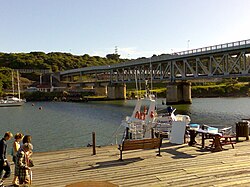Buffalo River (Eastern Cape)
| Buffalo River | |
|---|---|
 Road and rail bridge on the Buffalo River | |
 | |
| Native name | Buffelsrivier(Afrikaans) |
| Location | |
| Country | South Africa |
| State | Eastern Cape |
| Physical characteristics | |
| Source | Amatola Mountains |
| • elevation | 1,200 m (3,900 ft) |
| Mouth | Indian Ocean |
• location | East London |
• coordinates | 33°1′43″S27°51′51″E/ 33.02861°S 27.86417°E |
• elevation | 0 m (0 ft) |
| Length | 126 km (78 mi) |
| Basin size | 1,287 km2(497 sq mi) |
| Basin features | |
| Tributaries | |
| • left | Cwenqgcwe |
TheBuffalo Riveris situated in the city ofEast Londonon the East Coast of South Africa. It is to the west of theNahoon River.It is the only navigable river in South Africa.[citation needed]The town of East London was thus established around it.
Course
[edit]
The Buffalo River has its source in the seeps and sponges[clarification needed]of theAmatola Mountainsat an altitude of 1200 m.[1]The river is 126 kilometres long and drains a catchment of 1287 square kilometres.[1]From its source, the river descends through indigenous forest in a deeply incised channel, flanked by rock cliffs up to 120 metres high. The quality of these headwaters is good. After only seven kilometres, the river faces its first obstruction, the smallMaden Dam,built in 1910 (114 years old).[2]Four kilometres downstream of Maden Dam, the much largerRooikrantz Damimpounds about five million cubic metres. Rooikrantz Dam supplies water toKing William's Townand the surrounding areas. Twenty kilometres from its source, at an altitude of 450 metres above mean sea level, theCwengcwe RiverandIzele Riverjoin the Buffalo from the northeast. From here the river runs through undulating plains.
Two major tributaries from the west that join the middle section of the Buffalo River are theMgqakwebe Riverjust upstream of King William's Town and theNgqokweni RiveratZwelitsha.The other important tributary is theYellowwoods River,which flows from the north directly intoLaing Dam.When full, Laing Dam covers 203 hectares and contains 20 million cubic metres of water. From Laing Dam, the Buffalo River flows eastwards for 40 kilometres to Bridle Drift Dam, the largest impoundment on the river, with a full supply volume of 101 million cubic metres. Small streams on the northern bank bring runoff directly into Bridle Drift Dam fromMdantsane,the second largest township in Eastern Cape province.
FromBridle Drift Dam,the Buffalo River flows through low altitude coastal forest for twenty kilometres and forms the northern border of theUmtiza Nature Reserve,before entering theIndian Oceanthrough theestuaryharbour of East London.
Ecology
[edit]Theendangeredborder barblives in the waters of the Buffalo River.[3] There is also a small population of theendangeredEastern Province rocky(Sandelia bainsii)in the Yellowwoods River, part of the Buffalo River basin.[4]
Presently this river is part of theMzimvubu to Keiskama Water Management Area.[5]
Tributaries
[edit]Include theMgqakwebe River,Ngqokweni RiverandYellowwoods River,this last river includes some waterfalls the largest being theYellowwoods Falls,nearBreidbach.
See also
[edit]References
[edit]- ^ab"Report Highlights Impacts on River Health (Buffalo River)"(PDF).The Water Wheel(March/April): 8–11. 2005. Archived fromthe original(PDF)on 2013-06-11.Retrieved2013-06-11.
- ^"Maden Dam details".www.artefacts.co.za.Retrieved2024-04-17.
- ^Barbus trevelyani
- ^Sandelia bainsii
- ^Is there a role for traditional governance systems in South Africa's new water management regime?

